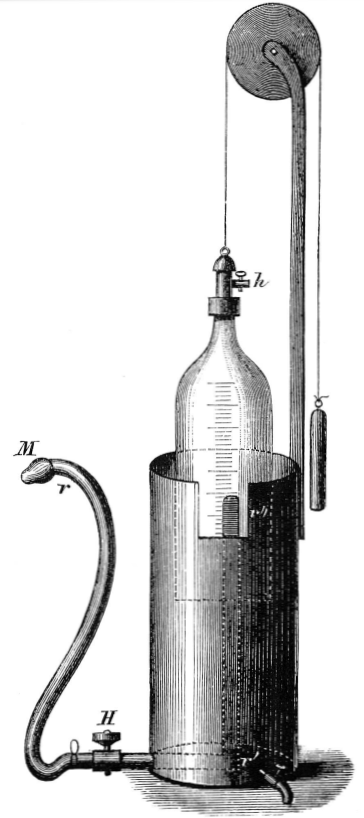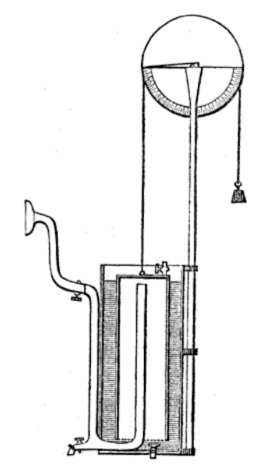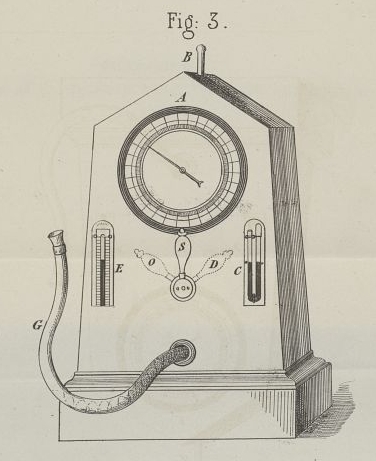
Spirometer devoloped by Anton Wintrich in 1854. From Genusus, Swiss Journal of the History of Medicine and Sciences, volume 38, 1981, an article titled “Die anfange der spirometrie im 19.Jahrhundert” by Mienem Lehrer, page 254.

Spirometer devoloped by Anton Wintrich in 1854. From Genusus, Swiss Journal of the History of Medicine and Sciences, volume 38, 1981, an article titled “Die anfange der spirometrie im 19.Jahrhundert” by Mienem Lehrer, page 254.

From “The Medical Examiner, and Record of Medical Science”, Volume 7, Issues 1-4, published by Lindsay & Blakiston, 1851, page 51.
“Another contribution from the domain of physics has been made, by Mr. Hutchinson, to the investigation of the respiratory functions in health and disease. It consists in an instrument he has invented, by which may be measured the amount of air that may be taken into and expelled from the lungs by voluntary effort; or what he calls “the vital capacity” of the lungs. By this instrument Mr. Hutchinson believes that incipient disease may be detected before physical signs exist. This instrument he names spirometer.
“On the table is an instrument of the kind. It is simple and less expensive than that of Mr. Hutchinson. It was planned by a gentleman of this city, Mr. Charles McKuen, who has been confined to his room for some months by a pulmonary affection; possessing an active mind, with a turn for philosophical pursuits, he occupies his time in scientific observations and investigations. I gave him Mr. Hutchinson’s paper, published in the Medico-Chirugical Transactions, containing a diagram of his instrument. Mr. McKuen constructed the instrument now before you on the same principles. I think it preferable to the original.
“The instrument will be seen to consist of a cylinder containing water, in which immersed is another cylinder inverted, into which the expired air finds its way. This cylinder is counterpoised by a weight attached to a cord passing over a wheel of large diameter, and which rotates with the ascent of the cylinder, caused by the entrance of expired air, and on which a scale indicates the amount that has be introduced.
“The person using this instrument must first loosen and part of his dress that may restrain the movements of the chest or abdomen. He then deliberately expands his chest to its greatest extent, and expires through the mouthpiece and air tube into the cylinder. As this rises the wheel turns round, and an index marks on the scale, in inches, the amount expired.”

Described as a “dial” spirometer. It’s mode of operation was not described however appearances aside it is likely a water-seal spirometer. Legend of illustration:
A. Dial indicator of the respiratory vital capacity.
B. Movable iron rod which serves to lower the tank after each experiment.
C. Manometer.
D. Thermometer.
G. Air entry channel.
S. D.O. positions that can give the S faucet and allowing or forbidding the entry of air into the device.
Manufacturer was not named. From “Essai sur le spiromètre”, by Louis-Emile Hecht, published in Strasbourg by G. Silbermann, 1855. Found on the Medic Database.
From The American Journal of Medicine, 1859, page 379.
“1859, Jan. 5. Improved Spirometer – Dr. S. W. Mitchell exhibited an improved form of spirometer, of which he gave the following description: –
“While conducting some recent researches upon the physical statistics of natives of this country, I was struck with the clumsiness, and, in some cases, with the inaccuracy, of the form of spirometer in common use. This instrument, well known as Hutchinson’s spirometer, is accurate in its indications when well made, but is always inconvenient, because it requires to be filled with water, and, on account of its weight and form, is not easily carried from place to place. This latter objection applies equally to all the spirometers I have examined; while most of the instruments on the side of the water are also open to the additional objection of want of accuracy.
“The instrument which I have used in its place is merely a small “dry gasmeter” numbers of which are made in this city by Messrs. Code, Hopper & Co. With the aid of Mr. Gratz, a member of this firm, some slight alterations have been made in the valves of the meter, and the inlet-pipe was somewhat narrowed. A large dial-plate, graduated to inches and halves of inches, was placed on top of the meter, so that the rotation of an indicating hand would mark the number of cubic inches which passed through the machine.
“It is unnecessary to describe the interior details of the meter thus adapted to spirometric use. In the form of a dry gas-meter it has been used, almost to the exclusion of the very inconvenient “wet-meter” in many parts of this country, and has been found to perform its work of registration, for years together, without serious error and without needing repairs.
“The instrument thus briefly described is figured in the annexed cut. Its height as but fourteen inches, its width eleven. The inlet-pipe is so marked, and to this, when arranged for use, an India-rubber tube and mouthpiece are attached. The inlet and outlet-pipes form convenient handles when the spirometer is to be carried.
“I have tested the accuracy of this little instrument with great care, and have put to more severe trials than the meter is usually subjected to. Its indications appeared to be to be almost perfect. The new form of spirometer runs with so little friction, that a pressure of one-eighth of an inch of water will move it readily. One source of error is thus avoided, since, if the instrument did not move so easily the first air blown into it would be more or less condensed, and so occupy less space than it should do.
“After the spirometer has been used fifty or sixty times, the moisture from breath, which collects in the form of a few drops of water within the instrument, should be allowed to escape by the removal of a button placed underneath the meter.
“The form of spirometer here described has lately been employed by the biological department of the Academy of Natural Sciences of this city, to measure the pulmonary capacity of some five hundred men. In every way the instrument was found to be satisfactory,being portable, requiring no water, and not being readily deranged.
“So far as the committee have gone, hey have seen increasing reason to regard with distrust all spirometric valuations of men. In every case they have been careful, by repeated trials, to obtain the best result of which the individual was capable; but the have been, so far, much impressed with the difference between their own results and those obtained buy others abroad. As the height, weight and girth of chest have also been taken, the committee hope, at some future time, to be able to report in detail their results, as bearing upon the lung capacity of men born in this country.
“The spirometer is to be obtained from Messrs. Code & Hopper of this city, well known as manufacturers of gas-meters. The cost of the new instrument will probably not exceed fifteen dollars, which is less than that of the worst ordinary spirometer now in use.”
From Lehrbuch der physiologie des menschen : Unter mitwirkung der herren prof. Chapter XXII Stoff-und Kraftwechsel by Nathan Zuntz, page 637, published by FCW Vogel , 1913.
Likely the first closed-circuit system for measuring oxygen consumption and CO2 production. Developed by Regnault and Reiset in the 1850’s.
From Comptes rendus hebdomadaires des séances de l’Académie des sciences, December 1856, page 1047. “Note sur un spirometre d’une sensibilite’ et d’une simplicite’ extremes par M.B. Schnepf”.
The spirometer bell was described as 35 cm high and 18 cm in diameter, the base cylinder was described as 30 cm high and 16 cm in diameter. The breathing tube was 15 mm in diameter. Note that the chain varied in width (and therefore weight) along its length. This was designed to vary the counter weight used to suspend the bell according to its depth in the water.
From Patrimoine Scientifique et Technique De L’Universite De Strasbourg. Described as made by the Pixxi family in Paris who were manufacturers of scientific instruments. Stated to be manufactured before 1850.